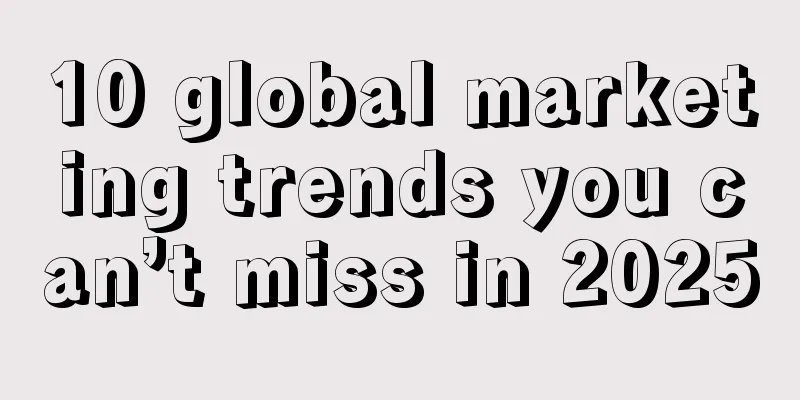10 global marketing trends you can’t miss in 2025

Kantar has released the global marketing trends worth paying attention to in 2025, including sustainable development, live streaming, social media and generative AI, showing the key areas of growth and development in the coming year. The following are the 10 key trends that will emerge globally in 2025: 1. Start your omnichannel video journeyOver the past decade, smart TVs have gone mainstream, blurring the lines between broadcast TV and streaming. According to TGI 2024, although broadcast TV still has a wide reach, 50% of viewers say their TV viewing is mainly concentrated on streaming. Advertisers face difficulties when choosing TV advertising. The solution lies in diversification. Viewer viewing habits vary by region and demographic, with some markets preferring subscription video on demand (SVOD) and others leaning toward advertising-supported video on demand (AVOD). According to Kantar data, 55% of global advertisers plan to increase their investment in streaming TV in 2025, while advertising investment in broadcast TV will gradually spread to a wider range of video platforms including YouTube. The key is to test and find the best video combination strategy that suits the brand and different goals. 2. Use innovative content to gain influence on social mediaMarketers’ understanding of “attention” is changing, with a greater emphasis on the quality of engagement as it has the greatest impact on creative effectiveness. In Kantar 2024 research, 31% of people worldwide claimed that ads on social media platforms attracted their attention, a significant drop from 43% last year. People have become accustomed to the complex social media environment, and it is becoming increasingly difficult to attract their attention. In 2025, if brands want to continue to gain attention, they can't be satisfied with routine operations. Instead, they need to stand out on social media with innovative content. 3. Beware of the risks that generative AI may bringIn 2025, marketers will pay more attention to data privacy and security, and consumer-facing generative AI will need to be more transparent. Marketers’ enthusiasm for generative AI continues to grow. According to Kantar data, 68% of marketers have a positive attitude towards GenAI, and 59% are excited about its application in advertising. At the same time, 44% of marketers believe that they can identify AI-generated ads, while 43% of consumers do not trust AI-generated ads. Whether using generative AI to develop strategies or create content assets, to ensure the reliability of the underlying data of the AI model, marketers need to confirm that the data source is credible and make investment decisions based on the data. 4. Integrate sustainability into brand strategySustainability legislation in major economies will accelerate the corporate ESG agenda by 2025. In addition, 93% of consumers worldwide say they want to live a more sustainable lifestyle, which will force companies to consider sustainability as a future challenge. To date, marketers have performed poorly in effectively integrating sustainability and creating meaningfully different propositions and communications that resonate with consumers. Despite the challenges of sustainability, analysis of Kantar BrandZ data shows that sustainability has created $193 billion in value for the world's top 100 brands. Kantar predicts that the most active sustainable consumer group will continue to grow from 22% in 2023 to 29% in 2030. Marketers are equally enthusiastic, with 94% saying that their sustainability agenda needs to be more confident. As Jane Wakely, executive vice president and chief consumer and marketing officer and chief growth officer at PepsiCo Foods International, said: “Sustainability can’t be a marketing agenda. It has to be a company-wide agenda, and marketing’s job is to find real connections, make things relevant to consumers, and turn sustainability initiatives into growth drivers. 5. Leverage the creator community to build your brandCommunities are thriving in new ways. Goldman Sachs estimates that the creator economy will be a $250 billion industry by 2024 and could reach $480 billion by 2027. Creators help brands engage their target audience and build trust by building tight-knit content communities around topics such as parenting, sports or beauty. Research shows that creator-driven content excels in brand differentiation. Brands should integrate creator content into their overall strategy to ensure it resonates across platforms. In addition to revenue, creators also care about platform experience, influence, and persistence. Understanding the dynamic choices of creators is critical to platform user growth and advertising revenue. 6 The necessity of inclusionFor years, despite growing evidence of the impact of inclusion, marketers have underestimated its role as a strategic lever for growth. In a connected world shaped by demographic change, inclusion will continue to rise in importance as more people focus on it. According to Kantar’s 2024 Brand Inclusion Index, nearly 80% of people worldwide will consider a brand’s perception and opinion of diversity and inclusion when making a purchase, especially among Generation Z and Millennials, the LGBTQ+ community, people with different thinking and cognition, and people with disabilities. Diversity, equity and inclusion are also more important to high-growth, underserved populations: 89% of people in emerging economies say it is important, compared to 71% in developed markets. Additionally, according to the United Nations, 1 in 4 people worldwide will be African by 2050. This “Africanization” of the world presents brands with a unique opportunity to connect with a diverse audience that is seeking inclusivity and authentic representation. Generational change has also opened the door to a wider range of identities, and a new culture that expects everyone to be accepted and understood. In 2025, brands need to make inclusion a necessity, not a check-the-box task, to get more people to consume for future brand growth. 7 The Problem of Slowing Population GrowthPopulation growth is one way for categories to increase penetration, while population decline means fewer shoppers. The current global population growth rate is less than 1% per year, far below the peak in 1963. The growth rate is predicted to be 0.5% by the middle of this century and negative by the end of this century. The slowdown is indeed global - a handful of countries are already experiencing population declines. It may be easier to hold onto market share, as slower growth means fewer new consumers need to be added each year to maintain current levels. But growth will become more difficult. Kantar World Panel data shows that brands are five times more likely to grow if their categories are growing. And there are other factors at work. For example, young people are getting married and having children later and later, and falling fertility rates mean that older shoppers with less spending power will make up a larger portion of the market. At the same time, households are getting smaller, which, on the plus side, means there will be more households overall. 8. Brands need to push the limits of innovationWe see more brands working hard to innovate and grow. For example, Oreo and Ferrero are turning to ice cream products to expand their business segments. And Oral B is studying more ways to expand its influence in the field of toiletries. The most extreme example is Samsung, which has broken through its own category boundaries and entered the "Extra Mile" convenience store in the United States. By 2025, we will see more brands completely expand their boundaries. This is a must for large brands that can’t easily grow in other ways, but successful expansion through innovation is never easy. Because incremental growth often comes with risk. When entering new areas, brands must fully understand the overall opportunity. From Kantar’s perspective, if brands find new space, growth opportunities will double, and brands with high penetration and strong future growth potential (future forces) can expand into new areas and open up new sources of revenue if they reimagine their “purpose”. 9 Retail media networks are changingThe Retail Media Network (RMN) integrates and manages all retailers’ own digital media, including self-operated websites, APP applications, in-store digital screens (such as POP), private domain communities, online mini-programs, and off-site official media, etc., which can help brands reach consumers more closely. Research shows that by 2028, retail media will account for nearly a quarter of all media ad spending in the United States. This is because RMN’s first-party data enables precise targeting and personalized marketing. This means there is an opportunity to use detailed consumer insights to optimize ad spend and improve campaign effectiveness. In 2025, we will see that RMN is becoming an omnichannel marketing asset for CPG (fast-moving consumer goods brands, including food, beverages, daily chemicals, etc. in daily life) brands - they are not just short-term strategies. Kantar Media Reactions 2024 shows that 41% of marketers around the world plan to increase their advertising investment in retail media in 2025. 10 Live broadcast will be more vibrantIn recent years, live streaming in China has transformed business and brand building. Platforms such as Taobao Live, Douyin, and WeChat cover entertainment and shopping for almost half of the population. McKinsey predicts that by 2026, China's live e-commerce sales may account for 20% of China's total retail sales, and Generation Z and millennials will become the main audience. At the same time, marketers are too focused on behavioral indicators, thus ignoring indicators such as consumer emotional value and brand power. Successful brands generally carefully design engaging creative and narratives to retain audiences and motivate them to make repeat purchases. Kantar shows that live streaming ads can enhance short-term purchase intent and increase long-term brand affinity. For established brands, the focus is on building long-term assets, such as driving "satisfaction needs", which can lead to a 10% to 15% lift, while small and medium-sized brands should prioritize increasing awareness (potential lift of 10% to 23%) and directly sparking interest (up to 30% lift). The rise of social commerce has lowered the barrier to entry for small brands. For example, Made by Mitchell achieved sales of $1 million in 12 hours in a UK TikTok Shop event. Big brands must compete to protect their market share. Although social commerce is limited to fast-moving consumer goods and small commodities, it can also be expanded to all industries including automobiles and luxury fashion. Source: Kantar Marketing Trends 2025 |
>>: I was so amused by the copywriting of these zoos
Recommend
The new decade of second-hand e-commerce
In the new decade of the second-hand e-commerce in...
How much does it cost to invest in Amazon's no-source model? What ERP should be used?
It is not only Taobao, Pinduoduo and other domesti...
Shopee 9.9 Super Shopping Festival is coming, multiple positive factors drive consumption growth
August 31, 2023, China - Recently, the leading e-c...
Behind the 30-yuan underground mall renovation, the "county style" that became popular on the Internet
What is it like to spend 30 yuan on a renovation i...
GMV exceeds 80 million. Is Xiaohongshu going to enter the field of e-commerce live streaming?
Xiaohongshu’s current status in the live streaming...
In the AIGC era, how to strike a balance and measure?
Introduction: Using AI to make videos? With the pr...
Small self-media in county towns can make money!
How can county-level self-media realize profits? T...
What sites does Amazon have? How does it charge?
Friends who know about e-commerce know that if you...
Is “Healthy Milk Tea” a tax on your IQ?
Health preservation for college students, health p...
Lessons from the bankruptcy of top white-label streaming platforms: How to run a business without pursuing traffic dividends?
As the traffic dividend gradually fades, former to...
Can I cancel my bid on eBay? What are some tips for bidding?
Auctions are a popular way of shopping on the e-co...
How does Amazon enter a competitor's store? What are the benefits?
As the saying goes, knowing yourself and your enem...
Hema feels like it's back on track
This article deeply analyzes the strategic adjustm...
Can I return an item after 90 days of purchase on Amazon? Can I return an item after it has been unpacked?
If you purchase goods on Amazon's cross-border...
Taobao's first show sold 175 million yuan, and Oriental Selection has "three burrows for cunning rabbits".
This article details the process of Dongfang Zhenx...









